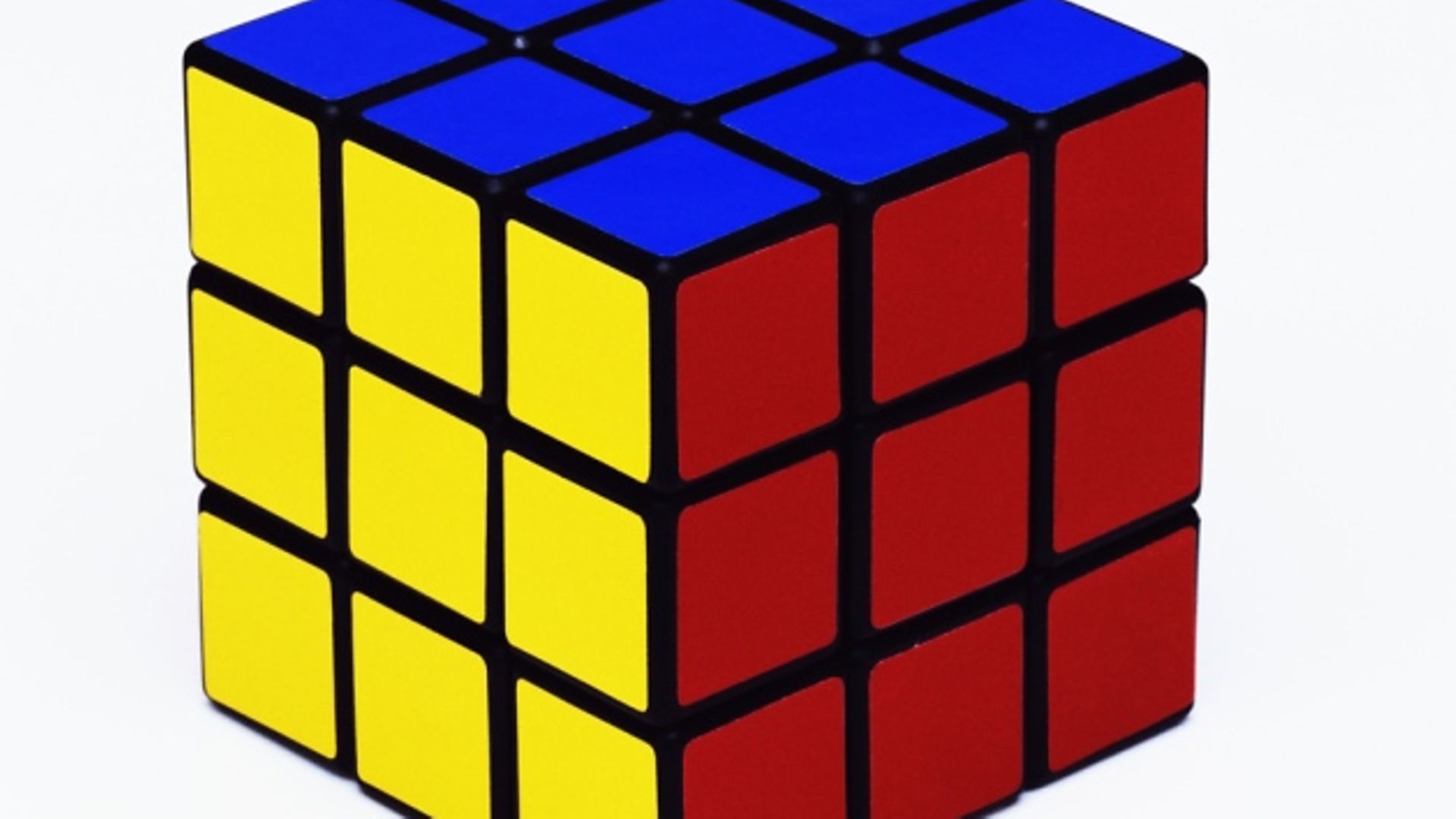
In 1980 there was one must-have toy. It didn’t need batteries. It didn’t speak or light up. It wasn’t a doll or action figure, nor was it linked to a film or cartoon. It was just a cube, made up of 26 smaller, coloured cubes which could be moved and interchanged. The Rubik’s Cube had taken the world by storm.
The cube had been invented six years earlier by Erno Rubik, in the cramped two-bedroom apartment he shared with his mother. The 29-year-old, an interior design lecturer at the Academy of Applied Arts and Design in the Hungarian capital, Budapest, had not intended to make a toy.
Instead he was fascinated by the inherent structural problem: was it possible to get the smaller, constituent cubes to move independently of each other without the larger cube falling apart?
His first attempt was a crude affair; a mini 2×2 cube made of eight smaller cubes held together by paper clips and rubber bands, which soon snapped after repeated use. It was also, due to the small number of blocks, fairly limited.
So, Rubik created a larger 3×3 cube with 26 smaller cubes moving around a central ‘core’ (essentially a 27th cube) to which the middle cubes on each six sides were attached. This ‘core’ allowed the central cubes to move up and down or left and right but always in line with the central cube directly opposite (for example, on a standard Rubik’s Cube the middle red cube will always be paired with the middle orange cube).
For the corners and edges, Rubik crafted cubes with protrusions at the back. These both created a circular ‘track’ and allowed the pieces to pivot around the middle cubes and the core within that track. The protrusions also interlocked to hold the cube together. Remove one piece and the rest would fall apart, leaving just the central cubes.
He also decorated the cubes so each side of the larger cube was a different colour. His prototype was bulky and made of wood but it worked and, other than a few minor refinements, the design has changed little since. Rubik began to play around with the cube, twisting the blocks, breaking up the solid walls of colour.
“It was wonderful to see how, after only a few turns, the colours became mixed, apparently in random fashion,” he would later write. Eventually he decided he wanted to reconfigure the cube in its original state, but he hit a problem.
A standard 3×3 Rubik’s Cube has just one correct permutation and more than 43 quintillion (that’s 43 with 18 zeros) incorrect ones. The more Rubik twisted the blocks to try and get the cube back to its original state, the more jumbled the colours became. Anyone who has ever attempted to solve a Rubik’s Cube knows how frustrating it can be. Rubik was the first to give it a go.
He was fascinated by the puzzle but without the aid of other people’s research and YouTube tutorials he wasn’t even sure if there was a solution. He began to wonder if he’d ever be able to re-form the cube in its original state, but he kept going and after a month of intense effort he did.
He showed the cube to his friends and when he saw that they too were enthralled he realised that he might have a puzzle toy on his hands. In early 1975 he applied for a Hungarian patent and approached Konsumex, the state trading company.
The wheels of production moved slowly behind the Iron Curtain and it was not until 1977 that Buvös Kocka (the Magic Cube) hit the shelves in Hungary. In the following five years, two million Magic Cubes were sold – one for every five Hungarians.
In 1979, Konsumex negotiated worldwide rights with Ideal Toys. As Rubik had not applied for an international patent, the cube was renamed the Rubik’s Cube, to afford Ideal at least some measure of copyright protection. It was released to the international market in early 1980.
In today’s highly digitised world it’s easy to forget that the Rubik’s Cube was launched in a decidedly analogue era. There was no internet, the home computer boom was just round the corner, but hadn’t arrived yet. VCRs were barely a decade old and the first Blockbuster store would not open until 1985. The fact that an infuriating coloured puzzle cube could beguile both children and adults alike was not a surprise.
It quickly became the fastest selling toy in history, with around 200 million sold in three years. Numerous people cashed in in other ways. There was a diverse range of imitations and more than 100 books purporting to reveal the secret to solving the puzzle were published. A plastic hammer called the Cube Smasher, with which you could take out your frustrations on the cube and “beat it into 43 quintillion pieces”, was produced. There was even a Saturday morning cartoon show for kids: Rubik, the Amazing Cube.
Clubs were formed to study the cube and uncover the solution with the fewest number of moves, which became known as ‘God’s algorithm’. Serious cubers took their cubes apart and lubricated the insides to create ‘racing cubes’. Then in June 1982 the 20 best cubers gathered in Budapest for first world championships and Minh Thai, a 16-year-old from Los Angeles, unscrambled the cube in a then-word record 22.95 seconds.
The huge success of the cube turned Rubik from an unknown academic earning $150 a month into Hungary’s first self-made millionaire almost overnight.
Yet almost as quickly, the craze died out and sales fell away. The frustration many had with being unable to unscramble the cube meant they were abandoned, unloved at the back of cupboards as people turned instead to computer games and video rentals.
While the rise in digital technology helped stifle the initial Rubik’s Cube boom, it would also ultimately spark the resurgence in its popularity.
Jessica Fridrich was the only female competitor at the 1982 World Championships and she never lost her love for cubing. A professor in electrical engineering, by 1997 she had come up with a series of algorithms for solving the puzzle and decided to post them on the internet, then just a few years old.
Her system quickly spread and has become one of the most popular methods used by speed cubers. The internet also created an environment for cubers to communicate with each other. In 2003 this online community came together to organise the second World Championship, in Toronto.
They also formed the World Cubing Association to oversee national and international competitions and records began to tumble. In 2007 Thibaut Jacquinot, from France, became the first person the solve a cube in under 10 seconds. In 2015, Lucas Etter, from the USA, broke the five-second barrier. Three years later China’s Yusheng Du broke the four-second barrier with a time of just 3.47 seconds, a record which still stands.
The last decade has been dominated by the Australian Feliks Zemdegs who, along with his friend and rival Max Park, of the US, is the subject of a Netflix documentary released earlier this year, The Speed Cubers. At 25, Zemdegs is considered a veteran in a world dominated by kids in their teens or even younger.
But the cube has appeal beyond these dedicated competitors. It is embedded in our popular culture and has made appearances in music videos by artists such as the Spice Girls and Taylor Swift as well as playing small but important roles in films as diverse as The Pursuit of Happyness, Snowden and Spider-Man: Into the Spider-Verse.
In 2017 sales of the Rubik’s Cube rose 45% year-on-year. Some $250 milion worth were sold, more than in any year since the 1980s heyday. Just like vinyl records, another ghost from the analogue past which has seen a recent rise in popularity, the Rubik’s Cube taps into feelings of nostalgia as well as the tangible pleasure of owning a physical product in the era of cloud storage.
But could that sudden rise in popularity also tell us something more fundamental about human nature? Erno Rubik once said: “If you are curious, you’ll find the puzzles around you. If you are determined, you will solve them.”
The year before that sales spike – 2016 – saw the election of Donald Trump and the Brexit vote usher in a period of seismic political and social upheaval. Perhaps at some level the Rubik’s Cube taps into a widespread desire to both understand an ever more complex and confusing world and a determination to solve its problems.









